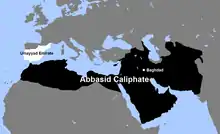763
Year 763 (DCCLXIII) was a common year starting on Saturday (link will display the full calendar) of the Julian calendar. The denomination 763 for this year has been used since the early medieval period, when the Anno Domini calendar era became the prevalent method in Europe for naming years.
| Millennium: | 1st millennium |
|---|---|
| Centuries: | |
| Decades: | |
| Years: |
| 763 by topic |
|---|
| Leaders |
|
| Categories |
|
| Gregorian calendar | 763 DCCLXIII |
| Ab urbe condita | 1516 |
| Armenian calendar | 212 ԹՎ ՄԺԲ |
| Assyrian calendar | 5513 |
| Balinese saka calendar | 684–685 |
| Bengali calendar | 170 |
| Berber calendar | 1713 |
| Buddhist calendar | 1307 |
| Burmese calendar | 125 |
| Byzantine calendar | 6271–6272 |
| Chinese calendar | 壬寅年 (Water Tiger) 3459 or 3399 — to — 癸卯年 (Water Rabbit) 3460 or 3400 |
| Coptic calendar | 479–480 |
| Discordian calendar | 1929 |
| Ethiopian calendar | 755–756 |
| Hebrew calendar | 4523–4524 |
| Hindu calendars | |
| - Vikram Samvat | 819–820 |
| - Shaka Samvat | 684–685 |
| - Kali Yuga | 3863–3864 |
| Holocene calendar | 10763 |
| Iranian calendar | 141–142 |
| Islamic calendar | 145–146 |
| Japanese calendar | Tenpyō-hōji 7 (天平宝字7年) |
| Javanese calendar | 657–658 |
| Julian calendar | 763 DCCLXIII |
| Korean calendar | 3096 |
| Minguo calendar | 1149 before ROC 民前1149年 |
| Nanakshahi calendar | −705 |
| Seleucid era | 1074/1075 AG |
| Thai solar calendar | 1305–1306 |
| Tibetan calendar | 阳水虎年 (male Water-Tiger) 889 or 508 or −264 — to — 阴水兔年 (female Water-Rabbit) 890 or 509 or −263 |
Events
Byzantine Empire
- June – Battle of Anchialus: Emperor Constantine V sends a Byzantine expeditionary force (800 ships and 9,600 cavalry) to Thrace, to defend the fortress city of Anchialus on the Black Sea Coast. Meanwhile, Telets, ruler (khagan) of the Bulgarian Empire, blocks the mountain passes and takes positions on the heights near Anchialus. During a desperate cavalry charge, the Bulgars are defeated and many are captured; Telets manages to escape. Constantine enters Constantinople in triumph, and kills all the prisoners.
Europe
- August – Byzantine troops invade the Papal States, in alliance with King Desiderius of the Lombards. King Pepin III ("the Short") intervenes, and begins negotiations between the Lombards and Pope Paul I. Desiderius promises to end the hostilities, but on condition that Pepin sends back Lombard hostages held by the Franks.[1]
Abbasid Caliphate

Abbasid Caliphate under Al-Mansur (r. 754–775) in black and Emirate of Córdoba in white
- In 763 Al-Mansur sent his troops to conquer Al-Andalus for the Abbasid empire. But the ruler Abd al-Rahman I successfully defended his territory. Al-Mansur withdrew and thereafter focused his troops on holding the eastern part of his empire on lands that were once part of Persia.[2]
- January 21 – Battle of Bakhamra: The Abbasid army under Isa ibn Musa defeats the Alids, and puts an end to their rebellion. The power of the Abbasid Dynasty is consolidated.
Asia
- February 17 – An Lushan Rebellion: Emperor Shi Chaoyi hangs himself to avoid being captured by Tang troops sent by the renegade Li Huaixian, ending the 7-year rebellion against the Tang Dynasty in China.
- November 18 – Forces of the Tibetan Empire, under Trisong Detsen, occupy the Tang capital of Chang'an (modern Xi'an) for 15 days, and install a puppet emperor.[3] Tibetans take over the horse pastures.
Births
- Haito, bishop of Basel
- Harun al-Rashid, Muslim caliph (or 766)
- Wang, empress of the Tang Dynasty (d. 816)
Deaths
References
- "CATHOLIC ENCYCLOPEDIA: Pope Paul I".
- Wise Bauer, Susan (2010). The History of the Medieval World: From the Conversion of Constantine to the First Crusade. W. W. Norton & Company. p. 369. ISBN 9780393078176.
- Beckwith 1987, p. 146
This article is issued from Wikipedia. The text is licensed under Creative Commons - Attribution - Sharealike. Additional terms may apply for the media files.